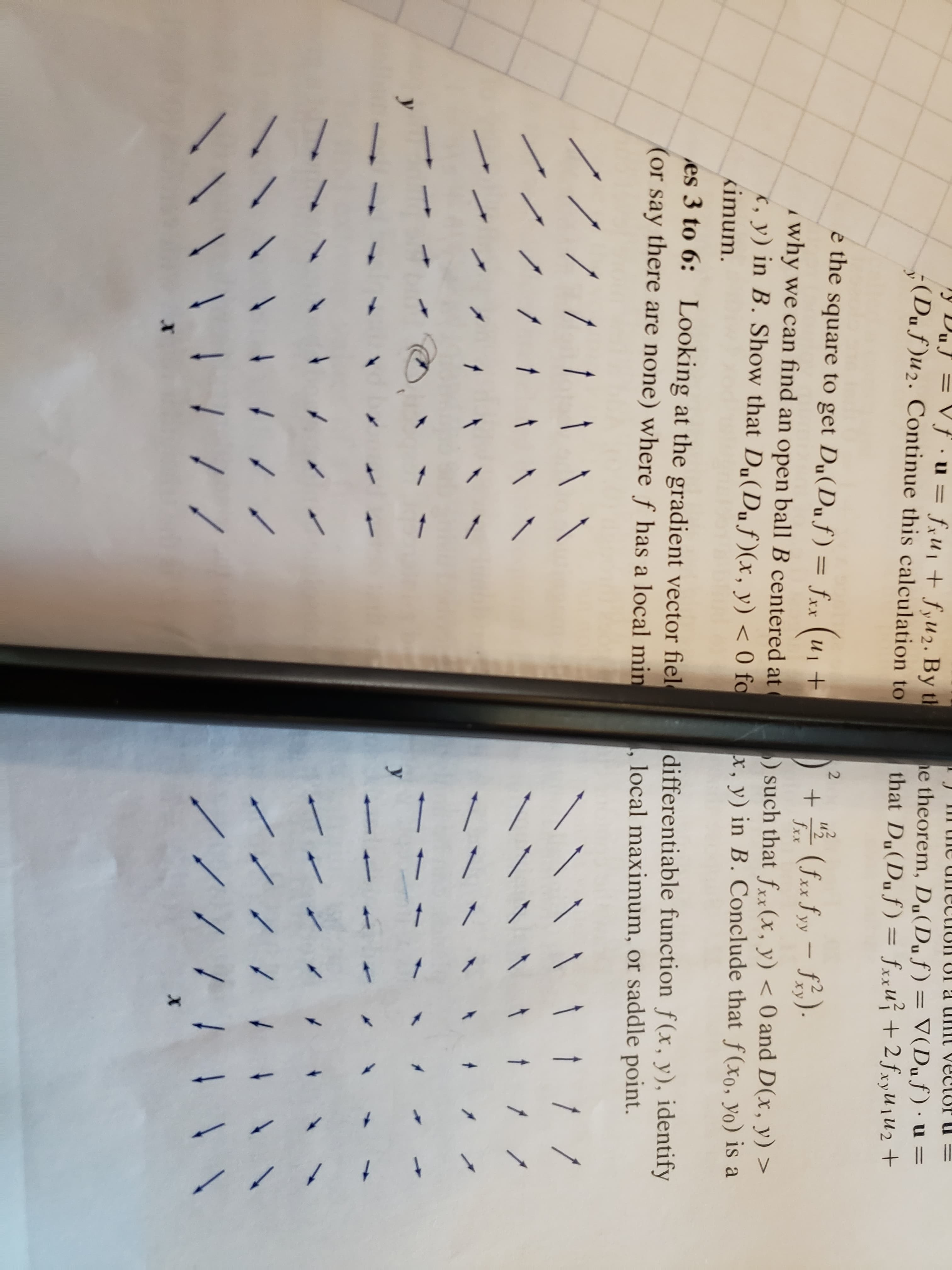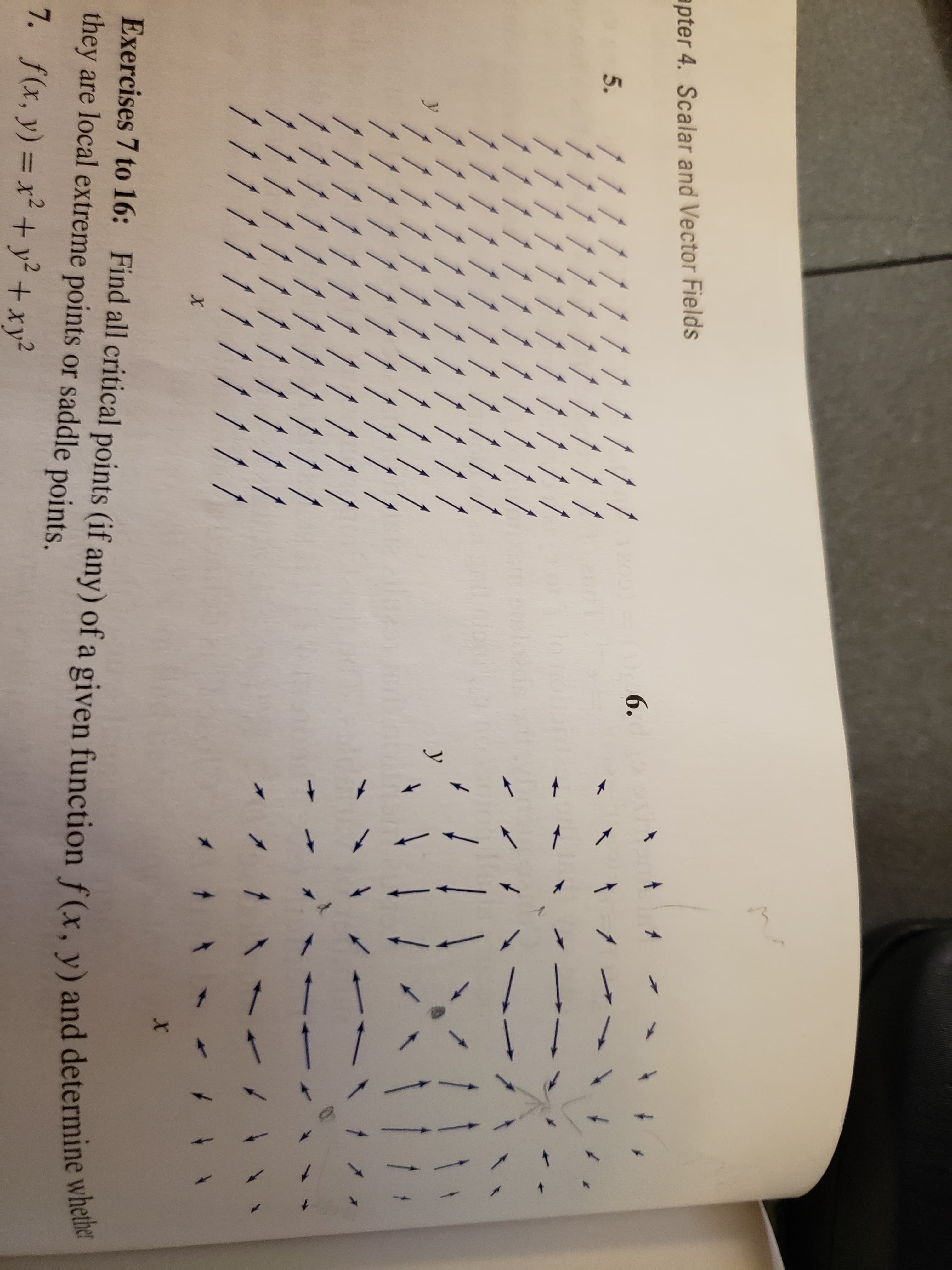In he unrection UI a unil vector U= y Du} = V ƒ •u= f,uj + fyu2. By t e theorem, D„(Duf)= V(Duƒ)·u= :(Duf)u2. Continue this calculation to %3D || that D(Duf)= fxxu¡ + 2 fxyuju2 + e the square to get Du(Duf) = fxx (u1 * (fxx fyy – f,). - fxx (why we can find an open ball B centered at ) such that f,(x, y) < 0 and D(x, y) > x, y) in B. Conclude that f (xo, yo) is a (, y) in B. Show that D„(Duƒ)(x, y) < 0 fo kimum. es 3 to 6: Looking at the gradient vector fiel (or say there are none) where f has a local min differentiable function f(x, y), identify , local maximum, or saddle point. 11 apter 4. Scalar and Vector Fields 6. 5. 11 У 1. Exercises 7 to 16: Find all critical points (if any) of a given function f(x, y) and determine wike they are local extreme points or saddle points. 7. f(x, y) = x2 + y² + xy²
In he unrection UI a unil vector U= y Du} = V ƒ •u= f,uj + fyu2. By t e theorem, D„(Duf)= V(Duƒ)·u= :(Duf)u2. Continue this calculation to %3D || that D(Duf)= fxxu¡ + 2 fxyuju2 + e the square to get Du(Duf) = fxx (u1 * (fxx fyy – f,). - fxx (why we can find an open ball B centered at ) such that f,(x, y) < 0 and D(x, y) > x, y) in B. Conclude that f (xo, yo) is a (, y) in B. Show that D„(Duƒ)(x, y) < 0 fo kimum. es 3 to 6: Looking at the gradient vector fiel (or say there are none) where f has a local min differentiable function f(x, y), identify , local maximum, or saddle point. 11 apter 4. Scalar and Vector Fields 6. 5. 11 У 1. Exercises 7 to 16: Find all critical points (if any) of a given function f(x, y) and determine wike they are local extreme points or saddle points. 7. f(x, y) = x2 + y² + xy²
Linear Algebra: A Modern Introduction
4th Edition
ISBN:9781285463247
Author:David Poole
Publisher:David Poole
Chapter1: Vectors
Section1.1: The Geometry And Algebra Of Vectors
Problem 4EQ
Related questions
Question
Explain which points on these graphs are local max/min/ saddle points. Also what is a saddle point? You should be able to tell from looking at the

Transcribed Image Text:In he unrection UI a unil vector U=
y Du} = V ƒ •u= f,uj + fyu2. By t e theorem, D„(Duf)= V(Duƒ)·u=
:(Duf)u2. Continue this calculation to
%3D
||
that D(Duf)= fxxu¡ + 2 fxyuju2 +
e the square to get Du(Duf) = fxx (u1
* (fxx fyy – f,).
-
fxx
(why we can find an open ball B centered at
) such that f,(x, y) < 0 and D(x, y) >
x, y) in B. Conclude that f (xo, yo) is a
(, y) in B. Show that D„(Duƒ)(x, y) < 0 fo
kimum.
es 3 to 6: Looking at the gradient vector fiel
(or say there are none) where f has a local min
differentiable function f(x, y), identify
, local maximum, or saddle point.

Transcribed Image Text:11
apter 4. Scalar and Vector Fields
6.
5.
11
У
1.
Exercises 7 to 16: Find all critical points (if any) of a given function f(x, y) and determine wike
they are local extreme points or saddle points.
7. f(x, y) = x2 + y² + xy²
Expert Solution
This question has been solved!
Explore an expertly crafted, step-by-step solution for a thorough understanding of key concepts.
This is a popular solution!
Trending now
This is a popular solution!
Step by step
Solved in 3 steps with 3 images

Knowledge Booster
Learn more about
Need a deep-dive on the concept behind this application? Look no further. Learn more about this topic, advanced-math and related others by exploring similar questions and additional content below.Recommended textbooks for you

Linear Algebra: A Modern Introduction
Algebra
ISBN:
9781285463247
Author:
David Poole
Publisher:
Cengage Learning

Algebra & Trigonometry with Analytic Geometry
Algebra
ISBN:
9781133382119
Author:
Swokowski
Publisher:
Cengage

Linear Algebra: A Modern Introduction
Algebra
ISBN:
9781285463247
Author:
David Poole
Publisher:
Cengage Learning

Algebra & Trigonometry with Analytic Geometry
Algebra
ISBN:
9781133382119
Author:
Swokowski
Publisher:
Cengage